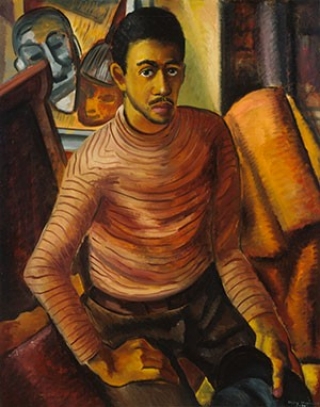Born 1896, Greensboro, North Carolina
Died 1934, New York City
Trained at the School of the National Academy of Design in New York, painter Malvin Gray Johnson first gained prominence in the city’s art world in 1928 when he began pictorially reimagining the African American spiritual. In works such as Swing Low, Sweet Chariot and Roll Jordan Roll, Johnson used an expressively darkened palette of lavenders, blues, and blacks to illustrate scenes taken from what African American historian and critic W. E. B. Du Bois labeled “the sorrow songs” of the American South. For many, including Du Bois and contemporary art commentator and philosopher Alain Locke, the spirituals were an authentic iteration of vernacular southern black folk culture and served as the first true American artistic innovation.
In Swing Low, Sweet Chariot, several black figures huddle together near a small cabin and stare upward at the sky. The image of a chariot led by two horses emerges from a cloud formation like a vision that holds the figures’ attention. Inspiration for this scene comes from the second verse of the spiritual, which reads: “I looked over Jordan and what did I see / Coming for to carry me home / A band of angels coming after me / Coming for to carry me home.” For Roll Jordan Roll Johnson strayed from a direct translation of the spiritual’s lyrics and concentrated on the symbolism of the River Jordan as a threshold between slavery and freedom. Nine figures in a boat row against cresting waves as they seek a promised land, the wind filling their sail.
In both of these works, Johnson’s darkened hues, somewhat reminiscent of Albert Pinkham Ryder, add a somber note that evokes the freedom struggles of African Americans fighting the bondage imposed by years of slavery. Yet Johnson offers viewers a vision of black striving, resistance, and transcendence in the face of adversity, as the figures seek refuge in the divine.
Nicholas Miller
Francis, Jacqueline. Making Race: Modernism and “Racial Art” in America. Seattle: University of Washington Press, 2012.
